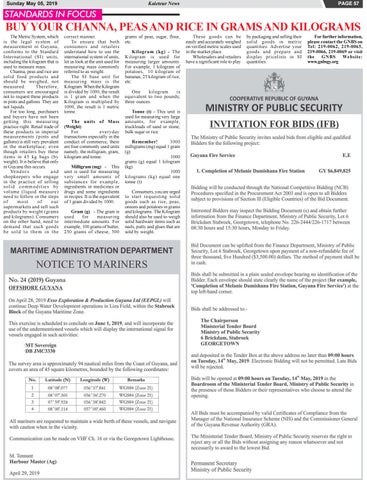Sunday May 05, 2019
PAGE 57
Kaieteur News
STANDARDS IN FOCUS
BUY YOUR CHANNA, PEAS AND RICE IN GRAMS AND KILOGRAMS The Metric System, which is the legal system of measurement in Guyana, conforms to the Standard International (SI) units, including the kilogram that is used to measure mass. Channa, peas and rice are solid food products and should be weighed, not measured. Therefore, consumers are encouraged not to request these products in pints and gallons. They are not liquids. For too long, purchasers and buyers have not been getting this measuring practice right. Retail trade of these products in imperial measurements (pints and gallons) is still very prevalent in the marketplace; even though retailers buy these items in 45 kg bags (by weight). It is believe that only in Guyana this occurs. Ve n d o r s and shopkeepers who engage in the practice of selling solid commodities by volume (liquid measure) need to follow in the steps of most of our supermarkets and sell such products by weight (grams and kilograms). Consumers on the other hand, need to demand that such goods be sold to them in the
correct manner. To ensure that both consumers and retailers understand how to use the international system of units, let us look at the unit used for measuring mass commonly referred to as weight. The SI base unit for measuring mass is the Kilogram. When the Kilogram is divided by 1000, the result is 1 gram and when the Kilogram is multiplied by 1000, the result is 1 metric tonne. The units of Mass (Weight) For everyday transactions especially in the conduct of commerce, there are four commonly used units namely, the milligram, gram, kilogram and tonne. Milligram (mg) - This unit is used for measuring very small amounts of substances for example, ingredients in medicines or drugs and some ingredients in recipes. It is the equivalent of 1 gram divided by 1000. Gram (g) - The gram is used for measuring intermediate amounts. For example, 100 grams of butter, 250 grams of cheese, 500
grams of peas, sugar, flour, etc. Kilogram (kg) - The Kilogram is used for measuring larger amounts. For example, 1 kilogram of potatoes, 10 kilogram of bananas, 25 kilogram of rice, etc. One kilogram is equivalent to two pounds, three ounces. Tonne (t) - This unit is used for measuring very large amounts, for example, truckloads of sand or stone, bulk sugar or rice. Remember! 1000 milligrams (mg) equal 1 gram (g) 1000 grams (g) equal 1 kilogram (kg) 1000 kilograms (kg) equal one tonne (t) Consumers, you are urged to start requesting solid goods such as rice, peas, onions and potatoes in grams and kilograms. The Kilogram should also be used to weigh solid hardware items such as nails, putty and glues that are sold by weight.
These goods can be easily and accurately weighed on verified metric scales used in the market place. Wholesalers and retailers have a significant role to play
by packaging and selling their solid goods in metric quantities. Advertise your goods and prepare and display pricelists in SI quantities.
For further information, please contact the GNBS on Tel: 219-0062, 219-0065, 219-0066, 219-0069 or visit the GNBS Website: www.gnbsgy.org
